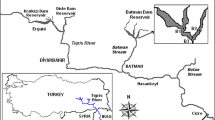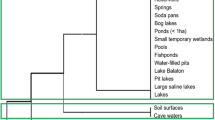Abstract
Protist communities were studied monthly at Santoña beach (Cantabrian Sea, Spain) throughout one year. Twelve abiotic parameters were analyzed. The following functional groups (defined according to the preferential source of food) were considered: photoautotrophs (P), saprotrophs (S), bacterivores (B), algivores (A), non-selectives (N), and predators or raptors (R). A total of 269 species was found. The percentage of species in each functional group was: 11.66% A, 33.66% B, 26.45% N, 28.02% P, and 0.21% R. No species belonging to functional group S were found. Functional groups B and N had the highest percentage of biomass (up to 100% in certain months). The percentage of biomass for each functional group was calculated. There was a remarkable negative correlation between groups B and N at the four sampling sites. The biomass percentage of group A was important at several sampling points in March, June, and July, coinciding with an increase in their source of food. The percentage of group P rose in April and May, the months the period of irradiance was longer. The canonical population analysis showed that there were no significant differences with respect to the composition in terms of functional groups at the four sampling sites. These data were compared with those found in the literature on both marine and freshwater areas, by means of a hierarchical conglomerate analysis. The statistical analysis showed that there are generally noticeable differences between these two types of media. It is suggested that each area may have a characteristic species composition respect to functional groups, which is influenced by the environmental parameters.
Similar content being viewed by others
Literature Cited
Al-Rasheid, K. A. S. andM. A. Sleigh. 1995. Distribution and abundance of interstitial ciliates in Southampton water in relation to physicochemical conditions, metal pollution and the availability of food organisms.Estuarine, Coastal and Shelf Science 41:61–80.
Alongi, D. M. 1986. Quantitative estimates of benthic protozoa in tropical marine systems using silica gel: A comparison of methods.Estuarine, Coastal and Shelf Science 3:443–450.
Andersen, T. andD. Hessen. 1991. Carbon, nitrogen, and phosphorus content of freshwater zooplankton.Limnology and Oceanography 36:807–814.
APHA. 1989. Standard Method for the Examination of Water and Wastewater, 17th edition. American Water Works Associaton and Water Pollution Control Federation, Washington, D.C.
Azam, F., T. Fenchel, J. G. Field, J. S. Gray, L. A. Meyer-Reil, andF. Thingstad. 1983. The ecological role of water column microbes in the sea.Marine Ecology Progress Series 10:257–263.
Baldock, B. M., J. H. Baker, andM. A. Sleigh. 1983. Abundance and productivity of protozoa in chalk streams.Holarctic Ecology 6:238–246.
Baldock, B. M. andM. A. Sleigh. 1988. The ecology of benthic protozoa in rivers: Seasonal variation in numerical abundance in fine sediments.Archiv fuer Hydrobiologie 111:409–421.
Bak, R. P. M. andG. Nieuwland. 1989. Seasonal fluctuations in benthic protozoan populations at different depths in marine sediments.Netherlands Journal of Sea Research 24:37–44.
Berninger, U. G. andS. S. Epstein. 1995. Vertical distribution of benthic ciliates in response to the oxygen concentration in an intertidal North Sea sediment.Aquatic Microbial Ecology 9:229–236.
Bott, T. L. andL. A. Kaplan. 1990. Potential for protozoan grazing of bacteria in streambed sediments.Journal of the North American Benthological Society 9:336–345.
Bratbak, G. 1987. Carbon flow in an experimental microbial ecosystem.Marine Ecology Progress Series 36:267–276.
Burkovsky, I. V. 1978. The structure, dynamics and production in a community of marine psammophilic ciliates.Zoologicheskii Zhurnal 57:325–337.
Butler, H. andA. Rogerson. 1996. Growth potential, production efficiency and annual production of marine benthic naked amoebae (gymnamoebae) inhabiting sediments of the Clyde Sea area, Scotland.Aquatic Microbial Ecology 10:123–129.
Button, D. K. 1985. Kinetics of nutrient-limited transport and microbial growth.Microbiological Reviews 49:270–297.
Cairns, Jr.,J., J. L. Plafkin, R. L. Kaesler, andR. L. Lowe. 1983. Early colonization patterns of diatoms and protozoa in fourteen fresh-water lakes.Journal of Protozoology 30:47–51.
Castro de Zaldumbide, M. 1993. Relaciones entre diversas comunidades de protozoos ciliados y la caracterización biologica del agua. Doc. Th. Universidad Complutense, Madrid, Spain.
Cuadras, C. M., C. Arenas, andJ. Fortiana. 1991. Multicua. Paquete No Standard de Análisis Multivariante. Publicationes del Departamento de Estadística, Universidad de Barcelona, Barcelona, Spain.
Dragesco, J. 1996. Infraciliature et morphométrie de cing espèces de ciliés mésopsammiques méditerranéens.Cahiers de Biologie Marine 37:261–293.
Epstein, S. S. 1995. Simultaneous enumeration of protozoa and micrometazoa from marine sandy sediments.Aquatic Microbial Ecology 9:219–227.
Epstei, S. S. 1997. Microbial food webs in marine sediments. I. Trophic interactions and grazing rates in two tidal flat communities.Microbial Ecology 34:188–198.
Estrada, M. 1982. Ciclo anual del fitoplancton en la zona costera frente a Punta Endata (Golfo de Vizcaya).Investigacion Pesquera 46:469–491.
Fenchel, T. 1968. The ecology of marine microbenthos. II. The food of marine benthic ciliates.Ophelia 5:73–123.
Fenchel, T. 1969. The ecology of marine microbenthos. IV. Structure and function of benthic ecosystem, its chemical and physical factors and the microfauna communities with special reference to the ciliated protozoa.Ophelia 4:121–137.
Fenchel, T. 1987. The Ecology of Protozoa. Springer-Verlag, Berlin, Germany.
Fenchel, T. andT. H. Blackburn. 1979. Bacteria and Mineral Cycling. Academic Press, London, U.K.
Fernández, E. 1990. Composición, distribución y producción del fitoplancton en el Cantábrico Central. Ph.D. Thesis, Universidad de Oviedo, Oviedo, Spain.
Fernandez-Galiano, D. 1976. Silver impregnation of ciliated protozoa: Procedure yielding good results with the pyridinated silver carbonate method.Transactions of the American Microscopical Society 95:557–560.
Fernandez-Leborans, G. andM. Castro de Zaldumbide. 1986. The morphology ofAnophrys arenicola sp. nov. (Ciliophora, Scuticociliatida).Journal of Natural History 20:713–721.
Fernandez-Leborans, G. andA. Novillo. 1993. Sublittoral protistan communities of the shores of the Sea of Cantabria (Bay of Biscay).Internationale Revue der Gesamten Hydrobiologie 78: 201–218.
Fernandez-Leborans, G. andA. Novillo. 1994. Experimental approach to cadmiun effects on a marine protozoan community.Acta Hydrochimica et Hydrobiologica 22:19–27.
Finlay, B. J., K. J. Clarke, A. J. Cowling, R. M. Hindle, andA. Rogerson. 1988. On the abundance and distribution of protozoa and their food in a productive freshwater pond.European Journal of Protistology 23:205–217.
Gates, M. A. andU. T. Lewg. 1984. Contribution of ciliated protozoa to the planktonic biomass in a series of Ontario Lakes: Quantitative estimates and dynamical relationships.Journal of Plankton Research 6:443–456.
Giere, O. 1993. Meiobenthology. Springer-Verlag, Berlin, Germany.
Gifford, D. J. 1991. The protozoan-metazoan trophic link in pelagic ecosystems.Journal of Protozoology 38:81–86.
Hagström, A., F. Azam, A. Anderson, J. Wikner, andF. Rassoulzadegan. 1988. Microbial loop in an oligotrophic pelagic marine system: Possible roles of cyanobacteria and nanoflagellates in organic fluxes.Marine Ecology Progress Series 49:171–178.
Hartwig, E. 1980. The marine interstitial ciliates of Bermuda with notes on their geographical distribution and habitat.Cahiers de Biologie Marine 21:409–441.
Heiskanen, A., T. Tamminen, andK. Gundersen. 1996. Impact of planktonic food web structure on nutrient retention and loss from a late summer pelagic system in the coastal northern Baltic Sea.Marine Ecology Progress Series 145:195–208.
Hobbie, J. E., R. J. Daley, andS. Jasper. 1977. Use of nuclepore filters for counting bacteria by fluorescence microscopy.Applied and Environmental Microbiology 33:1225–1228.
Kemp, P. F. 1988. Bacterivory by benthic ciliates: Significance as a carbon source and impact on sediment bacteria.Marine Ecology Progress Series 49:163–169.
Krumbein, W. C. 1939. Graphic presentation and statistical analysis of sedimentary data, p. 558–591.In P. D. Trask (ed.). Recent Marine Sediments. A Synposium (reprinted 1995 with review of advances since 1939). The American Association of Petroleum Geologists. Tulsa, Oklahoma, Murby & Co., London, U.K.
Kuuppo-Leinikki, P., R. Autio, S. Hâllfors, H. Kuosa, J. Kuparinen, andR. Pajuniemi. 1994. Trophic interactions and carbon flow between picoplankton and protozoa in pelagic enclosures manipulated with nutrients and top predator.Marine Ecology Progress Series 107:89–102.
Madoni, P. 1989. Community structure of the microzoobenthos in Lake Suviana (Tusco-Emilian Apennines).Bollettino di Zoologia 56:159–165.
Montagnes, D. J. S., D. H. Lynn, J. C. Roff, andW. D. Taylor. 1988. The annual cycle of heterotrophic planktonic ciliates in the waters surrounding the Isles of Shoals, Gulf of Maine: An assessment of their trophic role.Marine Biology 99:21–30.
Odum, H. T. 1983. Systems Ecology: An Introduction. Wiley Interscience, New York.
Page, F. C. 1983. Marine Gymnamoebae. Institute of Terrestrial Ecology. Lavenham Press, Suffolk, U.K.
Patterson, D. J., J. Larsen, andJ. O. Corliss. 1989. The ecology of heterotrophic flagellates and ciliates living in marine sediments.Progress in Protistology 3:185–268.
Pratt, J. R. andJ. Cairns, Jr. 1985. Functional groups in the Protozoa: Roles in differing ecosystems.Journal of Protozoology 32:415–423.
Rassoulzadegan, F. 1977. Evolution annuelle des ciliés pélagiques en Mediterranée nord-occidentale: Ciliés oligotriches “non-tintinnides” (Oligotrichina).Annales de l'Institut Oceanographique 53:125–134.
Salonen, K. andS. Jokinen. 1988. Flagellate grazing on bacteria in a small dystrophic lake.Hydrobiologia 161:203–209.
Santangelo, G. andP. Lucchesi. 1995. Spatial distribution pattern of ciliated protozoa in a Mediteranean interstitial environment.Aquatic Microbial Ecology 9:47–54.
Sherr, E. B. andB. F. Sherr. 1994. Bacterivory and herbivory: Key roles of phagotrophic protists in pelagic food webs.Microbial Ecology 28:223–235.
Sime-Ngando, T., M. Gosselin, S. Roy, andJ.-P. Chanut. 1995. Significance of planktonic ciliated protozoa in the lower St. Lawrence estuary: Comparison with bacterial, phytoplankton, and particulate organic carbon.Aquatic Microbial Ecology 9: 243–258.
Sleigh, M. A. 1987. Microbes in the Sea. Ellis Horwood Ltd., Chichester, U.K.
Starink, M., M.-J. Bár-Gilissen, R. P. M. Bak, andT. E. Cappenberg. 1996. Seasonal and spatial variations in heterotrophic nanoflagellate and bacteria abundances in sediments of a freshwater littoral zone.Limnology and Oceanography 41:234–242.
Stout, J. D. 1981. The role of protozoa in nutrient cycling and energy flow, p. 1–50.In M. Alexander (ed.). Advances in Microbial Ecology. Plenum Press, New York.
Tobiesen, A. 1991. The succession of microheterotrophs and phytoplankton within the microbial loop in Oslofjorden, May–October 1984.Journal of Plankton Research 13:197–216.
Tuffrau, M. 1967 Perfectionnements et pratique de la technique d'imprègnation au protargol des infusoires ciliés hypotriches.Protistologica 5:91–98.
Turner, J. T. andD. G. Borkman 1993. Plankton studies in Buzzards Bay, Massachussetts, USA. I. Hydrography and bacterioplankton, 1987 to 1990.Marine Ecology Progress Series 100:17–26.
Uhlig, G. 1964. Eine einfache Methode zur Extraktion der vagilen, mesopsammalen Mikrofauna.Helgolaender Meeresuntersuchungen 11:178–185.
Vadstein, O. andY. Olsen. 1989. Chemical composition and phosphate uptake kinetics of limnetic bacterial communities cultured in chemostats under phosphorous limitation.Limnology and Oceanography 34:939–946.
Varela, M. 1996. Phytoplankton ecology in the Bay of Biscay.Scientia Marina 60:45–53.
Wetzel, R. G. 1983. Limnology, 2nd edition. Saunders, New York.
Author information
Authors and Affiliations
Corresponding author
Rights and permissions
About this article
Cite this article
Fernandez-Leborans, G., Fernandez-Fernandez, D. Protist functional groups in a sublittoral estuarine epibenthic area. Estuaries 25, 382–392 (2002). https://doi.org/10.1007/BF02695981
Received:
Accepted:
Issue Date:
DOI: https://doi.org/10.1007/BF02695981




